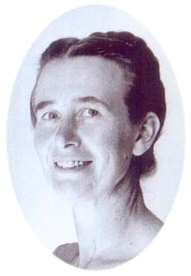Erica Deichmann Gregg
| Erica Deichmann Gregg | |
|---|---|
 | |
| Born |
Erica Luisa Matthiesen 23 July 1913 Denmark, Wisconsin |
| Died |
21 May 2007 (aged 93) Hampton, New Brunswick |
| Nationality | Canadian |
| Occupation | Studio potter |
| Years active | 1935–1963 |
Erica Deichmann Gregg CM (née Matthiesen; 23 July 1913 – 21 May 2007) was a Canadian studio potter. In the 1930s she and her first husband Kjeld Deichmann created Deichmann pottery, Canada's first studio pottery.[1]
Erica Luisa Matthiesen was born in Denmark, Wisconsin, one of five daughters of a Danish Lutheran pastor.[2] The family returned to Denmark when Erica was seven years old and she spent her childhood there. In the late 1920s the family moved to Canada and lived in Edmonton, where she met Kjeld Deichmann, a Danish immigrant. She married Deichmann in 1932 in Saint John, New Brunswick, and they settled on a farm on the Kingston Peninsula near Saint John.[3]
The Deichmanns spent a year in Europe, where Kjeld apprenticed as a potter with Axel Brüel, helping him to build a kiln, and Erica studied weaving. On their return to New Brunswick they set up a pottery studio at their home, which they called Dykelands because of the presence of several small dykes on their property. Kjeld built a wood-burning kiln in which they made their first firing in 1935.[4]
The Deichmanns were largely self-taught and perfected their production methods through constant experimentation regarding kiln design, clay composition, and glazes.[5]:197 Erica was responsible for inventing the glazes, of which she made over 5,000 experimental mixtures during her career as a potter.[6] She also decorated the pottery, usually painting on the raw clay before the work was fired in the kiln, and hand-modelled fanciful miniature animal forms which she called "goofi". [7]:14
In 1956 the Deichmanns moved their pottery studio to Sussex, New Brunswick. Kjeld Deichmann died suddenly in June 1963.[8] Erica closed the studio after her husband's death and stopped making pottery.[9]
In 1964 she married the Canadian war hero, politician and diplomat Milton Fowler Gregg, and was thereafter known as Erica Deichmann Gregg.[10] She was named a member of the Order of Canada in 1987. The citation to her appointment noted that in addition to being an "influential, international award-winning potter", she was an active volunteer for many organizations including "the Society for the Preservation of New Brunswick's Covered Bridges, the Beaverbrook Art Gallery, the Conservation council of New Brunswick and the Critical Natural Areas of New Brunswick Project".[11] In May 1992 the University of New Brunswick awarded her an honorary Doctor of Letters degree.[12]
Erica Deichmann Gregg died in Hampton, New Brunswick on 27 May 2007. She and Kjeld Deichmann had one son and two daughters, one of whom is the novelist and poet Elisabeth Harvor.[3]
References
- ↑ Inglis, Stephen (6 June 1991). "Curatorial statement: The Turning Point: The Deichmann Pottery (1935–1963)". Material Culture Review / Revue de la culture matérielle. 34 (1): 90–92. Retrieved 6 March 2016.
The Deichmanns are widely acknowledged to be the first studio potters in Canada: that is, the first to set up a studio, kiln and other facilities, which enabled them to produce a personalized series of domestic and decorative art pottery as a means of making a living.
- ↑ Gichuru, Anneke (31 July 2007). "Lives lived: Erica Deichmann Gregg". The Globe and Mail. Toronto. pp. L8.
- 1 2 "Erica Deichmann Gregg 1913 – 2007". Brenan's Funeral Homes & Crematorium. Retrieved 6 March 2015.
- ↑ "The Deichmann Collection: Danish Influence on Canadian Crafts". Canadian Museum of History. Retrieved 13 March 2016.
- ↑ Niergarth, Kirk (2015). "The Dignity of Every Human Being": New Brunswick Artists and Canadian Culture between the Great Depression and the Cold War. Toronto: University of Toronto Press. ISBN 978-1-4426-6320-6.
- ↑ "Deichmann, Erica". Canadian Women Artists History Initiative. Concordia University. 2007. Retrieved 11 March 2016.
Deichmann was particularly skilled with glazes (creating over 5,000 formulas) and surface treatment.
- ↑ Inglis, Stephen (1991). The turning point: the Deichmann pottery, 1935–1963 = Le tournant : la potterie Deichmann, 1935–1963. Hull, Quebec: Canadian Museum of Civilization = Musée canadien des civilisations. ISBN 0-660-50298-4.
- ↑ "Kjeld Deichmann". The Montreal Gazette. 15 June 1963. p. 20.
- ↑ Gotlieb, Rachel (2008). "Married to pottery: A life of uncertainty". In Alan C. Elder, Jean Johnson, Melanie Egan (eds.). Crafting New Traditions: Canadian Innovators and Influences. Canadian Museum of Civilization. pp. 15–24. ISBN 978-0-660-19784-5.
- ↑ "Milton Gregg weds Mrs. Erica Deichmann". The Globe and Mail. Toronto. 24 July 1964. p. 9.
- ↑ "Order of Canada: Erica Deichmann Gregg, C.M., R.C.A.". Governor General of Canada. 30 April 2009. Retrieved 6 March 2016.
- ↑ "UNB Honorary Degrees Database". University of New Brunswick. Retrieved 6 March 2016.